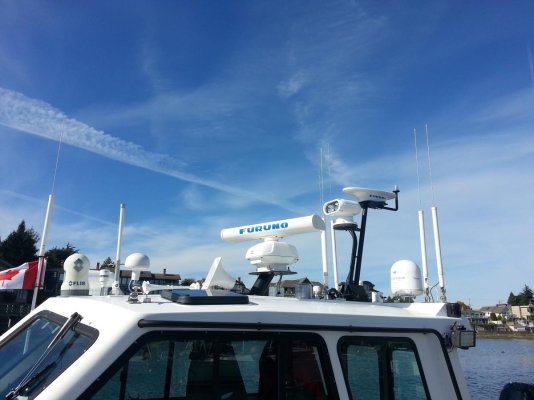- Joined
- Mar 17, 2012
- Messages
- 4,279
- Location
- Australia
- Vessel Name
- Insequent
- Vessel Make
- Ocean Alexander 50 Mk I
The thing I find most useful about AIS is the 'point of closest approach' graphic. The screen shows heading vectors for my boat and others, and indicates the position when the boats will be closest together, and shows how far apart that is. If I see someone without AIS that is heading my way than I acquire the target on the radar screen and shortly afterwards AIS-type info pops up on the nav screen - speed, heading and point of closest approach graphic. Not necessary, but convenient. If I figure that I would rather be a bit further away from them then tweaking the autopilot a few degrees to achieve that is simple to do. At times I will slow down or speed up to effect separation.
If you are seldom in areas where convergent traffic occurs then this feature of AIS is something you wouldn't use. For me, entering the Brisbane River from Moreton Bay, entering channels around the bay or heading for some anchorages within the bay it is something I use a lot even if there is good visibility.
A bit of nitpicking, only one E. EPIRB = Emergency Position Indicating Radio Beacon
I have the prescribed EPIRB for the boat, and also for the tender as it is mandatory for the tender as well if it is more than 3nm from the boat and I'm beyond smooth waters. But I also have a personal one for my own life-vest, with GPS. The latter functionality costs a little extra but takes 'search' out of search and rescue. If I ever need the thing I want rescue fast! As soon as personal sized AIS transmitters are cheaper I'll add them to a few other life-vests as well. And if I plan a cruise with much in the way of overnight legs then I'll get at least one so whoever is on watch has it. It can only be a matter of time before the offshore sailing racers make them standard equipment, and I'm hoping an expanded market will see prices tumble.
AIS MOB Devices
In the cold waters of the PNW and BC coasts, if people are going to be wearing life jackets for safety anyway then having an AIS MOB device attached to it makes a lot of sense to me. You have to get the MOB out of the water fast, and even in daylight if visibility is poor or there are whitecaps etc then finding the MOB really quickly is vital and may not be as simple as during your practice sessions. And yes, you probably also hit the MOB button on your chartplotter immediately, so an AIS MOB device isn't necessary... Each to their own.
If you are seldom in areas where convergent traffic occurs then this feature of AIS is something you wouldn't use. For me, entering the Brisbane River from Moreton Bay, entering channels around the bay or heading for some anchorages within the bay it is something I use a lot even if there is good visibility.
A bit of nitpicking, only one E. EPIRB = Emergency Position Indicating Radio Beacon
I have the prescribed EPIRB for the boat, and also for the tender as it is mandatory for the tender as well if it is more than 3nm from the boat and I'm beyond smooth waters. But I also have a personal one for my own life-vest, with GPS. The latter functionality costs a little extra but takes 'search' out of search and rescue. If I ever need the thing I want rescue fast! As soon as personal sized AIS transmitters are cheaper I'll add them to a few other life-vests as well. And if I plan a cruise with much in the way of overnight legs then I'll get at least one so whoever is on watch has it. It can only be a matter of time before the offshore sailing racers make them standard equipment, and I'm hoping an expanded market will see prices tumble.
AIS MOB Devices
In the cold waters of the PNW and BC coasts, if people are going to be wearing life jackets for safety anyway then having an AIS MOB device attached to it makes a lot of sense to me. You have to get the MOB out of the water fast, and even in daylight if visibility is poor or there are whitecaps etc then finding the MOB really quickly is vital and may not be as simple as during your practice sessions. And yes, you probably also hit the MOB button on your chartplotter immediately, so an AIS MOB device isn't necessary... Each to their own.
Last edited:




